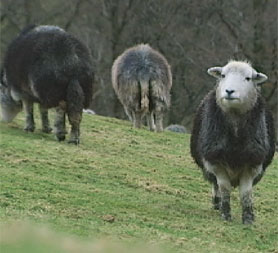Sheep breed resurrected decade on from foot and mouth
Amid fear a breed of sheep could be culled to extinction in the 2001 foot and mouth outbreak, a group of farmers set up a sheep gene bank which is coming to fruition a decade on, as Tom Clarke writes.
When foot and mouth disease (FMD) broke out in February 2001, farmers in Cumbria realised one of Britain’s most commercially important breeds of sheep might be culled to extinction. Now, a decade on, ewes are pregnant with lambs from these valuable sheep lost during the outbreak.
Herdwick sheep are ideally suited to life on the rain-soaked hills of the Lake District. A hardy breed with characteristic slate grey wool and white face it’s thought to have been bred here for about 1,000 years.
But when foot and mouth disease broke out here in 2001 and tens of thousands of sheep were being killed every week, breeders realised the Herdwicks might disappear from the county, and with them the genetic diversity of an entire ancient breed. While not rare – there are around 60,000 Herdwicks – 95 per cent of them are found in Cumbria alone.
We started thinking what we could do to save at least some of these sheep. Farmer Andrew Nicholson
Because of their hardiness they are valued by other sheep breeders for crossing with fatter lowland sheep to produce the highest quality meat. A Herdwick ram, or tup, can be worth tens of thousands of pounds.
“We realised it was coming back to hit us more and more, and we started thinking what we could do to save at least some of these sheep,” said Herdwick breeder Andrew Nicholson from the Lake District village of Lorton.
He contacted Dianna Bowles, a scientist at the University of York, but also an amateur sheep farmer. Within a few weeks Bowles had raised money, and mobilised a small team of vets and other farmers to collect sperm and embryos from vulnerable Herdwick sheep.
Decade on
A decade on, they have reconvened on Mr Nicholson’s farm to see if the material they collected back in 2001 is viable. Five of Mr Nicholson’s Herdwick ewes have been inseminated with sperm from rams he lost to FMD. Three other ewes, donated by 13-year old sheep farmer Evie Church, are acting as surrogate mums to embryos taken from Herdwick ewes culled back in 2001.
In all, a mini flock of 12 Herdwick sheep, resurrected from the FMD outbreak, will be born on Mr Nicholson’s farm in April.
“By the autumn, when we see what kind of sheep they’re turning into, that’s when we’ll be really pleased,” he said.
“Knowing the work everybody did ten years ago has been used now and was really worthwhile.”
For Andrew Nicholson, he’s recovering important bloodlines lost to foot and mouth. But the hundreds of samples the Herdwick project collected from other farms will now be kept in perpetuity.

Biological snapshot
In the end, the breed as a whole didn’t need saving. FMD never established itself on the highest of fells where only Herdwicks go. Around 20,000 were culled, but many escaped the cull.
However, what was collected represents a biological snapshot of sheep genetic diversity before foot and mouth. And that, says Dianna Bowles, turned out to be a very important thing.
As a result of the effort she founded the Sheep Trust to look after the hundreds of samples of sperm and embryos taken from Cumbrian Herdwicks.
Research carried out by her and local vet Amanda Carson confirmed that Herdwicks, and other commercially important breeds like South Wales Mountain sheep and South Country Cheviots, are so geographically isolated that they are very vulnerable to an outbreak of animal disease like FMD – or more recently bluetongue virus.
The work that the trust has done the last ten years has proven that geographical concentration is a risk and the fear, over and over again as these diseases hit, is that it is the breeds that are regionally isolated that are going to get hammered.
The Sheep Trust aims to expand their gene bank to protect other, commercially important, but potentially vulnerable breeds of sheep.
-
Latest news
-
‘Authentic Stupidity’: Ben Elton’s new show explores how idiotic human beings can be5m

-
Is Israel’s evacuation of Rafah the precursor to full scale invasion?3m

-
Eurovision: Non-binary artist wins for first time2m

-
Tens of thousands march in Georgian capital against ‘foreign agents’ bill2m

-
‘Russia’s number one goal is to get troops closer to Kharkiv,’ says Ukrainian security analyst4m

-




